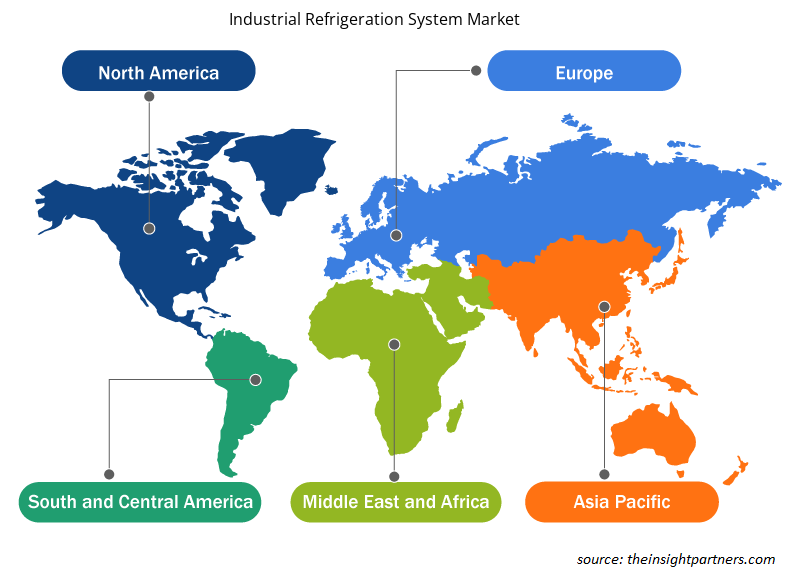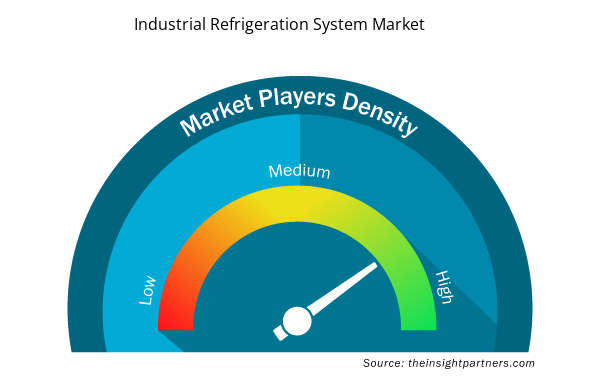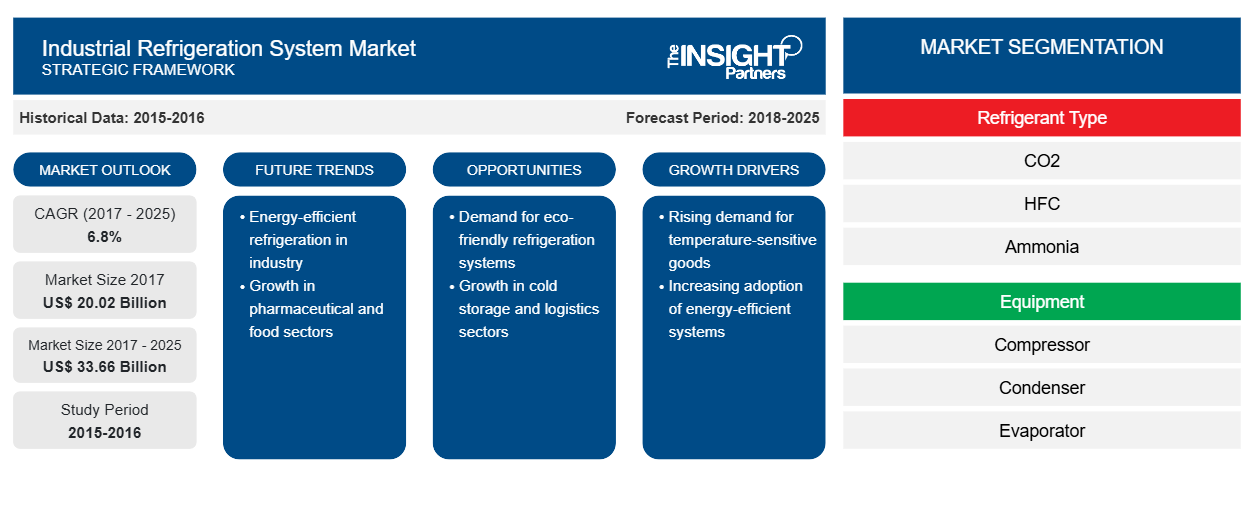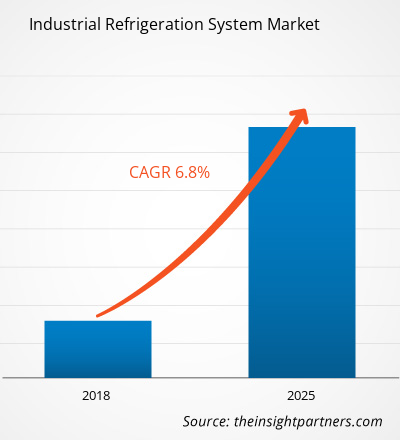El mercado de sistemas de refrigeración industrial se valoró en US$ 20.02 mil millones en 2017 y se proyecta que alcance los US$ 33.66 mil millones para 2025; se espera que crezca a una CAGR del 6,8% durante 2018-2025.
La importancia de los sistemas de refrigeración en industrias como la de procesamiento y almacenamiento de alimentos, productos químicos y farmacéuticos, petróleo y gas y la industria del transporte a nivel mundial ha ganado prominencia a lo largo de los años. Esto ha llevado a los fabricantes a innovar y diseñar continuamente sistemas de refrigeración tecnológicamente avanzados que han marcado una influencia significativa en los usuarios finales. Las innovaciones en el campo de los refrigerantes han sido testigos de varias alternativas y mejoras como el HFC a amoníaco y luego amoníaco a CO2 y nuevamente amoníaco (NH3) y CO2 en cascada. El HFC solía ser el refrigerante más destacado, sin embargo, debido a las desventajas como el alto ODP (potencial de agotamiento de la capa de ozono) y el alto GWP (potencial de calentamiento global), las características altamente inflamables y la naturaleza tóxica obligaron a los fabricantes a reemplazar el refrigerante con amoníaco (NH3). El sistema de refrigeración con amoníaco ha ganado una popularidad sustancial en el mercado debido a tres ventajas distintivas, como su ocurrencia natural y, por lo tanto, es un gas respetuoso con el medio ambiente, posee capacidades termodinámicas extremas y requiere áreas mínimas de transferencia de calor, lo que facilita a los fabricantes el uso de tuberías más pequeñas. Además, el gas NH3 es entre un 15% y un 20% más eficiente que los refrigerantes HFC tradicionales. Sin embargo, debido a la naturaleza higroscópica del gas, se evapora fácilmente y migra al medio ambiente, lo que provoca consecuencias peligrosas para los seres humanos y las máquinas cercanas debido a la toxicidad del gas. Otra desventaja de los vapores de amoníaco es su capacidad inflamable cuando se contaminan con aceite lubricante de la maquinaria. En el escenario actual, los fabricantes de sistemas de refrigeración industrial están utilizando dióxido de carbono CO2 individualmente, así como CO2 y NH3 en cascada como refrigerantes. El CO2 está fácilmente disponible y es mucho más barato en comparación con sus contrapartes, lo que ayuda a los fabricantes a reducir el costo inicial del producto final y también aumenta la eficiencia operativa del sistema. Además, la cascada de CO2 y NH3 posee mucha más eficiencia en refrigeración y también ahorra enormes cantidades de energía, lo que ayuda al usuario final a reducir sus costos operativos. Estas tendencias se están observando entre los fabricantes de sistemas de refrigeración industrial globales, lo que está impactando fuertemente en el crecimiento del sistema actualmente.
El futuro del mercado de sistemas de refrigeración industrial es prometedor, ya que los centros de investigación están continuamente innovando nuevas tecnologías e investigando sobre la sustitución de refrigerantes tradicionales para mejorar las características técnicas de la maquinaria y reducir los riesgos ambientales. Como resultado, se están desarrollando e integrando sistemas de sensores tecnológicamente enriquecidos, lo que se espera que atraiga a un número significativo de industrias en los próximos años.
Personalice este informe según sus necesidades
Obtendrá personalización en cualquier informe, sin cargo, incluidas partes de este informe o análisis a nivel de país, paquete de datos de Excel, así como también grandes ofertas y descuentos para empresas emergentes y universidades.
- Obtenga las principales tendencias clave del mercado de este informe.Esta muestra GRATUITA incluirá análisis de datos, desde tendencias del mercado hasta estimaciones y pronósticos.
Perspectivas del mercado: mercado de sistemas de refrigeración industrial
Demanda creciente de capacidades de almacenamiento de alimentos envasados
La tendencia de consumir alimentos envasados ha aumentado significativamente en los últimos años a nivel mundial, con marcas especiales en América del Norte y las regiones de Asia Pacífico. El consumo de alimentos envasados o productos alimenticios congelados ha crecido un 50% durante la última década en los EE. UU. Los consumidores de los países de América del Norte están más preocupados por el cambio de estilo de vida, la comodidad del consumo y también la conciencia de la salud. Estos factores están catalizando la demanda de alimentos envasados a nivel mundial. La industria de alimentos envasados ha superado en la región de América del Norte en los últimos años, debido al rápido aumento en el consumo de productos salados y lácteos, productos de confitería y otros productos. Otro producto alimenticio que está catalizando la demanda de alimentos envasados es la carne. La Administración de Alimentos y Medicamentos (FDA) de los Estados Unidos, bajo la ley Federal Food, Drug and Cosmetic Act (FFDCA), trabaja en estrecha colaboración con estas empresas de envasado de alimentos para entregar paquetes de la mejor calidad. La FDA también implementa varias reglas para omitir las sustancias antihigiénicas o insalubres del empaque. En relación con el beneficio del permiso del gobierno de los EE. UU., la adquisición de alimentos envasados ha aumentado en la región. El aumento del consumo de alimentos envasados también ha crecido en los últimos tiempos, lo que se atribuye al aumento sustancial de las tiendas minoristas y los grandes almacenes en la región. Debido a la creciente tendencia del consumo de alimentos envasados, están surgiendo varias empresas junto con empresas bien establecidas en la región. El crecimiento de las empresas de envasado de alimentos en la región ha llevado simultáneamente a la región a presenciar el crecimiento de los refrigeradores industriales. Esto se debe al hecho de que estos refrigeradores industriales son capaces de mantener temperaturas que varían ampliamente. Además de la variación de temperatura, estos refrigeradores industriales utilizan amoníaco y CO2 en su forma volátil o en cascada como agente de enfriamiento o refrigerantes, lo que es energéticamente eficiente y la combinación mejora la seguridad de la producción de alimentos, así como las áreas de envasado y almacenamiento de alimentos. Además, estos alimentos envasados también se almacenan en cámaras frigoríficas durante más tiempo con el objetivo de mantener la frescura del envase, lo que también exige refrigeradores industriales para mantener la temperatura deseada para los respectivos alimentos. Por lo tanto, el procesamiento y envasado de los alimentos, así como las capacidades de almacenamiento, son los principales factores que desencadenan el crecimiento del mercado de refrigeradores industriales en el escenario actual.
Información sobre segmentos de tipos de refrigerantes
Según el tipo de refrigerante, el mercado de sistemas de refrigeración industrial se segmenta en CO2, HFC y amoníaco. El calentamiento global y las condiciones ambientales cambiantes y las regulaciones de los organismos reguladores allegados desempeñan un papel importante en el funcionamiento del mercado de sistemas de refrigeración industrial. La elección del refrigerante ha experimentado cambios graduales en las adopciones a lo largo de los años debido a diversas demandas de cumplimiento en todo el mundo. El amoníaco y los hidrocarburos fueron los refrigerantes de primera elección utilizados en esta industria hasta hace unos años.
Perspectivas del segmento de equipos
Según el equipo, el mercado de sistemas de refrigeración industrial se divide en compresores, condensadores, evaporadores y otros. El mercado de sistemas de refrigeración industrial consta de componentes vitales que son fundamentales para su correcto funcionamiento. Compresores, condensadores, evaporadores y otros componentes más pequeños forman parte del sistema de refrigeración industrial.
Información sobre segmentos de aplicaciones
Según la aplicación, el mercado de sistemas de refrigeración industrial se divide en procesamiento de alimentos, productos químicos y farmacéuticos y logística refrigerada. Las industrias de procesamiento de alimentos aportaron la mayor participación en los ingresos en 2017 en la región, en relación con la rápida demanda creciente de alimentos congelados, carnes preparadas refrigeradas, confiterías, cervecerías y procesamiento de leche líquida entre la masa norteamericana. Estados Unidos es uno de los mayores consumidores de alimentos envasados y alimentos congelados, seguido de los países desarrollados de Europa. Además, otras regiones del mundo, como Oriente Medio y las economías en desarrollo de APAC, exhiben patrones cambiantes en la demanda de alimentos envasados y productos alimenticios.
Los actores del mercado se centran en innovaciones y desarrollos de nuevos productos integrando tecnologías y características avanzadas en sus productos para competir con los competidores.
2018: GEA Group firmó un acuerdo de préstamo de 150 millones de euros hasta 2025 con el Banco Europeo de Inversiones (BEI) para financiar su gasto en investigación, desarrollo e innovación.
2018: Carnot Refrigeration firmó un acuerdo de distribución con Emergent Cold Technologies. En virtud de este acuerdo, Emergent Cold entregará los sistemas de CO2 de Carnot Refrigeration a sus clientes presentes en varias regiones de EE. UU.
2017: EVAPCO, Inc. anunció su plan de expandir su planta de fabricación en Taneytown invirtiendo US$ 15 millones.
Perspectivas regionales del mercado de sistemas de refrigeración industrial
Los analistas de Insight Partners explicaron en detalle las tendencias y los factores regionales que influyen en el mercado de sistemas de refrigeración industrial durante el período de pronóstico. Esta sección también analiza los segmentos y la geografía del mercado de sistemas de refrigeración industrial en América del Norte, Europa, Asia Pacífico, Oriente Medio y África, y América del Sur y Central.

- Obtenga datos regionales específicos para el mercado de sistemas de refrigeración industrial
Alcance del informe de mercado de sistemas de refrigeración industrial
| Atributo del informe | Detalles |
|---|---|
| Tamaño del mercado en 2017 | US$ 20.02 mil millones |
| Tamaño del mercado en 2025 | US$ 33,66 mil millones |
| Tasa de crecimiento anual compuesta (CAGR) global (2017-2025) | 6,8% |
| Datos históricos | 2015-2016 |
| Período de pronóstico | 2018-2025 |
| Segmentos cubiertos | Por tipo de refrigerante
|
| Regiones y países cubiertos | América del norte
|
| Líderes del mercado y perfiles de empresas clave |
|
Densidad de actores del mercado de sistemas de refrigeración industrial: comprensión de su impacto en la dinámica empresarial
El mercado de sistemas de refrigeración industrial está creciendo rápidamente, impulsado por la creciente demanda de los usuarios finales debido a factores como la evolución de las preferencias de los consumidores, los avances tecnológicos y una mayor conciencia de los beneficios del producto. A medida que aumenta la demanda, las empresas amplían sus ofertas, innovan para satisfacer las necesidades de los consumidores y aprovechan las tendencias emergentes, lo que impulsa aún más el crecimiento del mercado.
La densidad de actores del mercado se refiere a la distribución de las empresas o firmas que operan dentro de un mercado o industria en particular. Indica cuántos competidores (actores del mercado) están presentes en un espacio de mercado determinado en relación con su tamaño o valor total de mercado.
Las principales empresas que operan en el mercado de sistemas de refrigeración industrial son:
- Refrigeración Carnot
- Compañía Eléctrica Emerson
- Corporación de tecnologías unidas
- Sistemas de refrigeración innovadores, Inc.
- Johnson Controls, Internacional Plc.
Descargo de responsabilidad : Las empresas enumeradas anteriormente no están clasificadas en ningún orden particular.

- Obtenga una descripción general de los principales actores clave del mercado de sistemas de refrigeración industrial
Mercado de sistemas de refrigeración industrial: por tipo de refrigerante
- CO2
- HFC
- Amoniaco (NH3)
Mercado de sistemas de refrigeración industrial: por equipo
- Compresor
- Condensador
- Evaporador
- Otros
Mercado de sistemas de refrigeración industrial: por aplicación
- Procesamiento de alimentos
- Productos químicos y farmacéuticos
- Petróleo y gas
- Logística Refrigerada
Mercado de sistemas de refrigeración industrial por geografía
América del norte
- A NOSOTROS
- Canadá
- México
Europa
- Francia
- Alemania
- Italia
- Reino Unido
- Rusia
- Resto de Europa
Asia Pacífico (APAC)
- Porcelana
- India
- Corea del Sur
- Japón
- Resto de APAC
Oriente Medio y África (MEA)
- Sudáfrica
- Resto de MEA
América del Sur (SAM)
- Brasil
- Argentina
- Resto de SAM
Mercado de sistemas de refrigeración industrial: perfiles de empresas
- Refrigeración Carnot
- Compañía Eléctrica Emerson
- Corporación de tecnologías unidas
- Sistemas de refrigeración innovadores, Inc.
- Johnson Controls, Internacional Plc.
- PLC de Ingersoll-Rand
- Compañía Evapco, Inc.
- Grupo GEA AG
- Corporación Hussmann
- Corporación Dover
- Análisis histórico (2 años), año base, pronóstico (7 años) con CAGR
- Análisis PEST y FODA
- Tamaño del mercado Valor/volumen: global, regional, nacional
- Industria y panorama competitivo
- Conjunto de datos de Excel



Report Coverage
Revenue forecast, Company Analysis, Industry landscape, Growth factors, and Trends

Segment Covered
This text is related
to segments covered.

Regional Scope
North America, Europe, Asia Pacific, Middle East & Africa, South & Central America

Country Scope
This text is related
to country scope.
Trends and growth analysis reports related to Electronics and Semiconductor : READ MORE..
The List of Companies
1. Carnot Refrigeration
2. Emerson Electric Co.
3. United Technologies Corporation
4. Innovative Refrigeration Systems, Inc.
5. Johnson Controls, International Plc.
6. Ingersoll-Rand PLC
7. Evapco, Inc.
8. GEA Group AG
9. Hussmann Corporation
10. Dover Corporation
The Insight Partners performs research in 4 major stages: Data Collection & Secondary Research, Primary Research, Data Analysis and Data Triangulation & Final Review.
- Data Collection and Secondary Research:
As a market research and consulting firm operating from a decade, we have published and advised several client across the globe. First step for any study will start with an assessment of currently available data and insights from existing reports. Further, historical and current market information is collected from Investor Presentations, Annual Reports, SEC Filings, etc., and other information related to company’s performance and market positioning are gathered from Paid Databases (Factiva, Hoovers, and Reuters) and various other publications available in public domain.
Several associations trade associates, technical forums, institutes, societies and organization are accessed to gain technical as well as market related insights through their publications such as research papers, blogs and press releases related to the studies are referred to get cues about the market. Further, white papers, journals, magazines, and other news articles published in last 3 years are scrutinized and analyzed to understand the current market trends.
- Primary Research:
The primarily interview analysis comprise of data obtained from industry participants interview and answers to survey questions gathered by in-house primary team.
For primary research, interviews are conducted with industry experts/CEOs/Marketing Managers/VPs/Subject Matter Experts from both demand and supply side to get a 360-degree view of the market. The primary team conducts several interviews based on the complexity of the markets to understand the various market trends and dynamics which makes research more credible and precise.
A typical research interview fulfils the following functions:
- Provides first-hand information on the market size, market trends, growth trends, competitive landscape, and outlook
- Validates and strengthens in-house secondary research findings
- Develops the analysis team’s expertise and market understanding
Primary research involves email interactions and telephone interviews for each market, category, segment, and sub-segment across geographies. The participants who typically take part in such a process include, but are not limited to:
- Industry participants: VPs, business development managers, market intelligence managers and national sales managers
- Outside experts: Valuation experts, research analysts and key opinion leaders specializing in the electronics and semiconductor industry.
Below is the breakup of our primary respondents by company, designation, and region:

Once we receive the confirmation from primary research sources or primary respondents, we finalize the base year market estimation and forecast the data as per the macroeconomic and microeconomic factors assessed during data collection.
- Data Analysis:
Once data is validated through both secondary as well as primary respondents, we finalize the market estimations by hypothesis formulation and factor analysis at regional and country level.
- Macro-Economic Factor Analysis:
We analyse macroeconomic indicators such the gross domestic product (GDP), increase in the demand for goods and services across industries, technological advancement, regional economic growth, governmental policies, the influence of COVID-19, PEST analysis, and other aspects. This analysis aids in setting benchmarks for various nations/regions and approximating market splits. Additionally, the general trend of the aforementioned components aid in determining the market's development possibilities.
- Country Level Data:
Various factors that are especially aligned to the country are taken into account to determine the market size for a certain area and country, including the presence of vendors, such as headquarters and offices, the country's GDP, demand patterns, and industry growth. To comprehend the market dynamics for the nation, a number of growth variables, inhibitors, application areas, and current market trends are researched. The aforementioned elements aid in determining the country's overall market's growth potential.
- Company Profile:
The “Table of Contents” is formulated by listing and analyzing more than 25 - 30 companies operating in the market ecosystem across geographies. However, we profile only 10 companies as a standard practice in our syndicate reports. These 10 companies comprise leading, emerging, and regional players. Nonetheless, our analysis is not restricted to the 10 listed companies, we also analyze other companies present in the market to develop a holistic view and understand the prevailing trends. The “Company Profiles” section in the report covers key facts, business description, products & services, financial information, SWOT analysis, and key developments. The financial information presented is extracted from the annual reports and official documents of the publicly listed companies. Upon collecting the information for the sections of respective companies, we verify them via various primary sources and then compile the data in respective company profiles. The company level information helps us in deriving the base number as well as in forecasting the market size.
- Developing Base Number:
Aggregation of sales statistics (2020-2022) and macro-economic factor, and other secondary and primary research insights are utilized to arrive at base number and related market shares for 2022. The data gaps are identified in this step and relevant market data is analyzed, collected from paid primary interviews or databases. On finalizing the base year market size, forecasts are developed on the basis of macro-economic, industry and market growth factors and company level analysis.
- Data Triangulation and Final Review:
The market findings and base year market size calculations are validated from supply as well as demand side. Demand side validations are based on macro-economic factor analysis and benchmarks for respective regions and countries. In case of supply side validations, revenues of major companies are estimated (in case not available) based on industry benchmark, approximate number of employees, product portfolio, and primary interviews revenues are gathered. Further revenue from target product/service segment is assessed to avoid overshooting of market statistics. In case of heavy deviations between supply and demand side values, all thes steps are repeated to achieve synchronization.
We follow an iterative model, wherein we share our research findings with Subject Matter Experts (SME’s) and Key Opinion Leaders (KOLs) until consensus view of the market is not formulated – this model negates any drastic deviation in the opinions of experts. Only validated and universally acceptable research findings are quoted in our reports.
We have important check points that we use to validate our research findings – which we call – data triangulation, where we validate the information, we generate from secondary sources with primary interviews and then we re-validate with our internal data bases and Subject matter experts. This comprehensive model enables us to deliver high quality, reliable data in shortest possible time.


 Obtenga una muestra gratuita de este informe
Obtenga una muestra gratuita de este informe